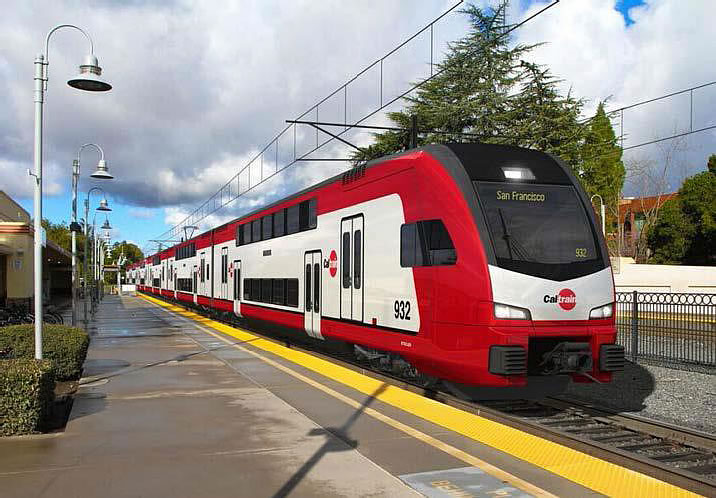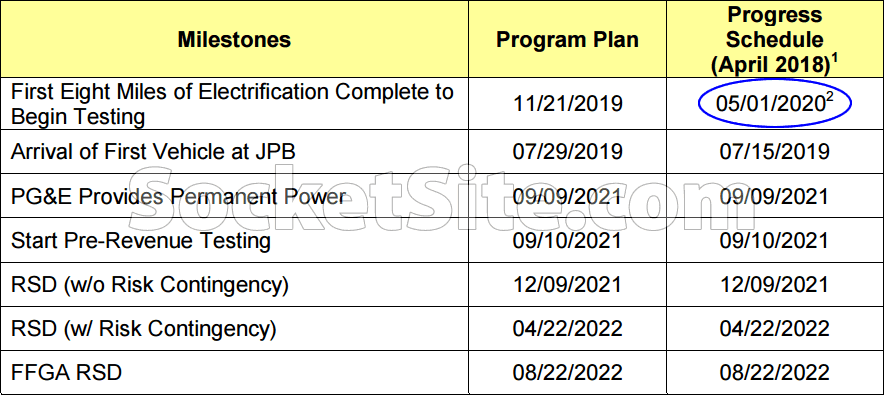As we first reported last year, the risk-adjusted timeline for the completion of Caltrain’s electrification and modernization project had slipped from the second to last day of 2021 to April of 2022, which included five (5) months of budgeted leeway for project risk factors and a reduced allocation of time for pre-revenue testing of the service.
And while the official risk-adjusted Revenue Service Date remains April of 2022, the projected timeline to complete the first eight miles of electrified track and begin testing, which is a major project milestone, is currently running six (6) months behind schedule, a delay which is now “being evaluated” by the project team.
In addition to a whole host of environmental, operating cost and other benefits – such as setting the stage for High Speed Rail (HSR) and a downtown extension (DTX) to San Francisco’s Transbay Transit Center – the electrification project will significantly increase Caltrain’s capacity and ability to run more trains during peak hours.
we’ll keep you posted and plugged-in.


This is the type of reporting where Socketsite truly excels. Great catch.
Always remember, we get older each year, but Caltrain electrification somehow remains 4 years from now.
I have a dream that one day I will walk the 10 minutes to the little used Caltrain station by my house and ride a modern electric train (like other civilized people) to the new Transbay Terminal. I am 42 years old. I think it is likely in my 60’s. I think unlikely I will ever ride the same train across the Bay which is a shame but this is America after all
The first – and I think one of only 2-3 times – I road this route, was to the Big Game…in 1981. It was still run by the SP, I believe, but other than that it’s essentially unchanged. (And you, I figure, were five…so your timing is better than mine)
What was the route then?
I have dream of riding a bus across the Bay Bridge in a contra flow bus only lane. For the life of me, I couldn’t figure out if something as sensible as this would be funded by RM3, which was just passed.
I’m not surprised as there is very little evidence of shovels in the ground. It is odd because when this project was originally delayed by the Trump administration last year we paid $20M to the contractors to sit on the bench while the funding was secured. I thought that meant that the project was shovel ready. Instead it seems as if there was still design work left to be done before actual construction begins.
This is really getting off to a slow start. It would be nice if Caltrain approached the project as if it were a product that needed to get on the market ASAP.
This is not factually correct– you can see metal supports for the catenary wires going up between Millbrae and 22nd already. There’s a lot of utility relocation work to be done as well.
Check this site for details about specific segments.
It is unfortunate that most people who will benefit from Caltrain are ambivalent and think BART is somehow superior.
>the electrification project will significantly increase Caltrain’s capacity and ability to run more trains during peak hours.
Actually…no. The electric cars have LESS capacity than the diesel ones. By a lot. The reason that the statistics show higher capacity, is that Caltrain is using the assumption that they will continue running diesel trains, and they will make the diesel trains longer than they are now. Each diesel train will have a whopping 910 seats compared with only 567 on an electric train. If they don’t keep running diesel and even then, with longer trains, capacity goes DOWN, not up.
We’re being sold a lie. Here’s their spreadsheets.
How is it possible that a six car electric train has 567 seats but a 7 car diesel train has 910 seats? I looked at the layout and it is not that different from today’s train. Except it seems they could have lot more seats in the mid level.
The empty space near doors on the lower-level is probably for passenger circulation and ADA compliance.
I think the electric have less capacity because there is no engine. Each car propels itself, or at least some of them do. That means there are electric motors taking up interior space. It’s better in that there is no single point of failure, but you can see the slight of hand with extra long diesel trains (that will require a complete redo of ALL of the platforms) being stuffed in between the electric ones so that they can claim greater capacity. You can imagine the outcry if they spent all this money and got less capacity, which is exactly what all the money is for.
Also, imagine how unhappy Caltrain’s neighbors will be when they now have ugly poles to look at and the diesel fumes are still there, all because they didn’t notice the fact that without the diesels, the whole plan collapses, making the fumes, and the poles, a permanent part of the landscape.
First, the diesel fleet will remain with bombardier cars, so the capacity of a 6-car set will be closer to 815. As for why a 6-car EMU will have less capacity? Well, three factors:
1) Each EMU set has the equivalent “guts” of 2 electric locomotives
2) Stadler’s ADA bathroom takes up more space than Bombardier layout
3) Extra set of doors. In order for Caltrain to eventually transition to level boarding, it needs two sets of doors, and seating capacity is a small penalty that was expected.
On a good note:
1) The layout of new cars have better capacity for those standing
2) Level boarding will mean shorter stops and a faster runtime
3) Caltrain already is getting funding to expand the fleet to 8-car EMUs, so by the time new fleet is launched, each car will have higher capacity than today.
I don’t think the poles are ugly. Not any more ugly than street lights. Also, poles imply there’s no dirty diesel pollution an noise. So yea, you gotta think a bit more what the poles imply, but that strikes me as people who don’t like offshore wind-farms because they’re ugly, even though there’s likely an ugly coal plant belnching CO2.
Any insight into why Caltrain would purchase new diesel trains for the line? Do they continue further south where the line isn’t going to be electrified?
There is no engineering issues that limit seats in electrical trains vs diesel that I know of.
There are no plans to electrify south of Diridon that I know of.
Thank you – just saw your post after my own below 🙂
This is the case for the CalMod project. However, the CHSRA’s most recent business plan now proposes that the entire Caltrain line be electrified in the near term as a way to prepare for eventual high speed rail service along the same tracks, currently estimated to begin in the late 2020’s.
So, while this is not yet funded or scheduled (a prospective date of 2027 is provided), there are now the beginnings of plans to electrify the entire Caltrain line presumably as some sort of CalMod phase 2.
Just checked on the Caltrain site, the electrification project is only to Tamien station so diesel trains will be needed for the sets that go all the way to Gilroy.
A trains capacity is not simply the number of seats. New cars leave more room in the middle for standing passengers. This makes sense given the high peak demands during commutes.
Seeing as how you are the expert on such things, perhaps you could point out where all that extra room is.
Perhaps near the doorways (as is the case with Caltrain’s current fleet of newer cars and also appears to be the case with the cars at the link you provided)
Yes, perhaps…but isn’t one of the major premises that the ‘lectrics can accelerate faster, so they can run shorter, but more frequent, trains ??
Yes, and the elimination of at-grade crossings aka grade separations will allow for higher speeds as well.
False! Caltrain doesn’t run slower due to grade crossings, which can be traversed at up to 110 mph if trains are equipped with in-cab signaling… which Caltrain and most RRs don’t, so per FRA rules, max allowable speed is 79 mph.
You need to check your information regarding safe rail road crossings. Having at-grade crossings for a passenger train is absolutely insane and not seen in most developed countries. I have seen cars holding up Caltrain when traffic is backed up onto the rails which couldn’t help capacity (but you can build grade separations without electrifying the line).
No. The reason there will be higher capacity is electric train have a higher acceleration and deceleration, so you can run more trains on an electrified track.
That’s not Caltrain’s spreadsheet.
I was going to ask — whose spreadsheet is that? The source is not verifiable.
Regardless of whose spreadsheet it is, it contradicts – rather than supports – the premise of the very person who posted it: the bottom line – literally – is a 10+% increase over current levels. One might argue that’s merely b/c of more trains, but it’s also b/c more trains are possible.
How are more trains possible? The trains accelerate and come up to max speed faster, saving a total of 30 seconds between stations.
The most constrained time of day is southbound between 6:59am and 7:58am, where the trains run 7 or more minutes apart from 4th and King to 22nd street. There are only 5 trains running in that one hour period, 12 minutes per train on average. There’s already more room for 3 more trains, and if you run them 7 minutes apart vs 6.5, it won’t make that much difference.
So they could add capacity now, without electrifying, if they had the money for more equipment, without the overhead of the electric system that now has to be put in place.
Peninsula Corridor Electrification Project: Capacity Increase Background Information
UPDATE: Master Schedule for Modernization of Caltrain Officially Slips